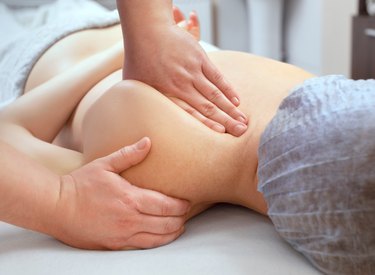
Your shoulder area consists of many muscles involved in stabilizing the shoulder girdle. Muscle spasms in your shoulder area are painful and may refer pain to other parts of your body, such as your neck, arms, head and hands. The knotted muscles apply pressure to underlying nerves, causing the pain referral.
The Supraspinatus Muscle
Video of the Day
The supraspinatus muscle covers the shoulder blade. The supraspinatus muscle is located on the top of the shoulder blade and connects with the tendon at the top of the arm, explains SportsInjuryClinic.net. This muscle is important in lifting the arm up and sideways and in making throwing motions. Muscle knots in this muscle may cause pain in your neck and shoulder. In addition, supraspinatus spasms can cause pain and stiffness when you attempt to lift or throw.
Video of the Day
Tight Subscapularis Muscle
The subscapularis is one of the muscles responsible for most shoulder pain, according to the Institute for Integrative Healthcare. It's located under your shoulder blade with its origin in the subscapular fossa and insertion on the lesser tubercle of the humerus. The subscapularis muscle is responsible for medial rotation of your arm and stabilization of the glenohumeral joint.
Symptoms of a subscapularis spasm are pain between your shoulder blades that radiates down your arms. In addition, a spasm in this muscle may cause headaches, numbness and tingling in your upper extremities and tension in your neck. Pain and stiffness may be present when medially rotating your arm on the affected side.
Read more: Exercises to Reduce Shoulder Blade Pain
Rhomboid Muscle Anatomy
Your rhomboid muscle is responsible for many upper body activities. According to The Hospitalist, a publication of the Society of Hospital Medicine, the origin of the rhomboid is on your last cervical and first few thoracic vertebrae, and insertion is on the inner border of your scapula.
A rhomboid spasm may be caused by overuse of your arm and shoulder — mostly during overhead activities such as serving a tennis ball or putting objects on a high shelf. It may also result from too much computer use or waiting tables and holding a tray over your head.
Symptoms of rhomboid spasm include decreased range of motion of your shoulders and arms, a tender lump between your shoulder blades and referred pain into your neck and arms, which intensifies when the lump is palpated. In addition, stiffness in your upper back, neck and shoulders may be present.
Home Remedies for Muscle Knots
According to Mayo Clinic, muscle knots, or cramps, can usually be treated with home remedies. Stretching a tight muscle or gently rubbing a muscle knot can help it to relax. Applying heat to the area, either with a heating pad or hot shower will increase blood flow and help the muscle relax. As a different option, ice can be applied to help numb pain.
Muscle knots in the shoulder blade can also be caused by weakness in other muscles of the shoulder. In addition, the way you perform your daily activities can be contributing to your muscle spasms. See a physical therapist for an individualized exercise program if you have a knot in your shoulder blade.
Read more: How to Stretch a Shoulder Knot